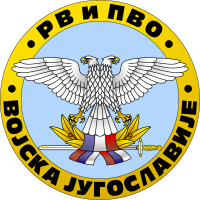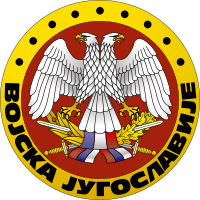Armed Forces of Serbia and Montenegro
| Armed Forces of Serbia and Montenegro | |
|---|---|
| Војска Србије и Црне Горе Vojska Srbije i Crne Gore | |
 Serbia and Montenegro Armed Forces' seal | |
| Founded | May 20, 1992 |
| Current form | Serbian Armed Forces Armed Forces of Montenegro |
| Disbanded | June 5, 2006 |
| Service branches | |
| Headquarters | Belgrade, Serbia, Serbia and Montenegro |
| Leadership | |
| President | |
| Prime Minister | |
| Minister of Defence | |
| Chief of the General Staff | |
| Personnel | |
| Military age | 19 |
| Conscription | Yes |
| Active personnel | 114,000 (1999) |
| Reserve personnel | 400,000 (1999) |
| Related articles | |
| History | Bosnian War Kosovo War Preševo Valley conflict Albania–Yugoslav border incident |
| Ranks | Ranks and insignia of Serbia and Montenegro |
The Armed Forces of Serbia and Montenegro (Serbo-Croatian: Војска Србије и Црне Горе, Vojska Srbije i Crne Gore, ВСЦГ / VSCG) included ground forces with internal and border troops, naval forces, air and air defense forces, and civil defense. Preceding the VSCG was the Yugoslav Army (1992–2003; Serbo-Croatian: Војска Југославије, BJ / Vojska Jugoslavije, VJ, lit. 'Army of Yugoslavia')[1] from the remnants of the Yugoslav People's Army (JNA), the military of SFR Yugoslavia. The state, then named Federal Republic of Yugoslavia, participated in the Yugoslav Wars with limited direct intervention of its own armed forces. Following the end of the Wars and the constitutional reforms of 2003 by which the state was renamed "Serbia and Montenegro", the military accordingly changed its name. The military was heavily involved in combating Albanian separatists during the Kosovo War and Preševo Valley conflict, and also engaged NATO airplanes during the 1999 NATO bombing of Yugoslavia.
Upon the dissolution of Serbia and Montenegro with the Montenegrin independence referendum (2006), a fraction of the joint military was given to Montenegro, with the bulk of the force remaining in Serbia. Montenegro inherited the navy as Serbia is landlocked.
Organization
VJ
The Armed Forces of Yugoslavia (VJ) was organized into the following:
Ground Forces
- 1st Army
- Novi Sad Corps
- Belgrade Command
- Kragujevac Corps
- Independent units
- 2nd Army
- Podgorica Corps
- Užice Corps
- Independent units
- 3rd Army
- Niš Corps
- Leskovac Corps
- Priština Corps
- Independent units
- War Command
- Flotilla
- 81st
- 83rd
- 85th
- 108th
- 110th
- 82nd
- 69th
- 367th
- 9th
- 10th
- 27th
- 61st
- 223rd
- 9th
Air Force
VSCG
Ground Forces
Inventory
Ground Forces
- Armoured vehicles
- Artillery
- Air Defence
- Bofors 40 mm gun L/70
- M53/59 Praga – 100–200
- SA-7
- SA-14
- SA-18
- SA-9
- SA-13
- SA-3
- SA-6
- Infantry weapons
- CZ-99 Pistol 9 mm
- M70A/M70B1 Assault Rifles 7.62 mm
- M93 Black Arrow Long Range Rifle
- BGA
- M76 7.9 mm Sniper rifle
- M72 7.62 mm Machine gun
- M84 7.62 mm Machine gun
- M87 12.7 mm Heavy Machine gun[2]
- AT-3 Sagger
- AT-4 Spigot
- M79 "Osa" 90 mm
- M80 "Zolja" 64 mm rocket grenade launcher
Air Force
The inventory included MiG-21 (fighter/recon/trainer), MiG-29 (fighter/trainer), Soko J-22 (ground/recon/trainer), Soko G-2 (fighter/bomber/trainer), Soko G-4 (fighter/bomber/target/trainer, Antonov An-2 (cargo), Antonov An-26 (cargo), Yakovlev Yak-40 (VIP), Mil Mi-8 (multirole), Mil Mi-14 (anti-submarine), Kamov Ka-25 (anti-submarine), Kamov Ka-28 (anti-submarine), Aérospatiale Gazelle (attack/utility/recon).
| Yugoslav Navy (1992–2003) Navy of Serbia and Montenegro (2003–2006) | |
|---|---|
| Ратна морнарица Војске Југославије[a] (1992–2003) Ратна Морнарица Србије и Црне Горе[b] (2003–2006) | |
 Emblem of the Navy from 1992 to 2003 | |
| Active | May 1992 – June 2006 |
| Country | |
| Garrison/HQ | Kotor, Montenegro, Serbia and Montenegro |
| March | "Mi smo ratna mornarica!" (English: "We are the War Navy!")[3] |
| Insignia | |
| Ensign | |
| Jack | |
The Navy, known as the Yugoslav Navy (Serbo-Croatian: Ратна морнарица Војске Југославије, Ratna mornarica Vojske Jugoslavije, RMVJ, lit. 'War Navy of the Army of Yugoslavia') from 1992 to 2003 and the Navy of Serbia and Montenegro (Serbo-Croatian: Ратна Морнарица Србије и Црне Горе, Ratna Mornarica Srbije i Crne Gore, lit. 'War Navy of Serbia and Montenegro') from 2003 to 2006, was based in Kotor and was largely made of vessels inherited from the pre-1992 Federal Yugoslav Navy (Serbo-Croatian: Југословенска ратна морнарица, Jugoslovenska ratna mornarica, lit. 'Yugoslav War Navy').[4][5] During NATO's Operation Allied Force in 1999, the Navy took control over civilian shipping around Kotor, despite NATO's blockade[6] and in several actions the navy's warships fired at NATO aircraft that were on their way to strike Yugoslav targets.[7] The Navy claimed to have shot down three UAVs over Boka Kotorska. The images of the remains of one of them were displayed online.[8]
- Koni-class frigate (2)
- Kotor-class frigate (2)
- Heroj-class submarine (3)
- Sava-class submarine (2)
- Una-class submarine (5)
- Končar-class missile boat (6)
- Osa class missile boat (10)
- Jadran sailboat
- Neštin class minesweeper (7)
- Kozara river ship
Intelligence
Operational experience
- Croatian War and Bosnian War (1992–1995), unofficially, logistical support and supplies
- Insurgency in Kosovo (27 May 1995 – 28 February 1998), belligerent, counter-terrorism
- Kosovo War (28 March 1998 – 11 June 1999), including NATO bombing of Yugoslavia (23 March – 10 June 1999), belligerent
- Insurgency in the Preševo Valley (12 June 1999 – 1 June 2001), belligerent, counter-terrorism
Statistics

Civilians fit for military service were estimated at about 4,888,595 (2001 est.). The 2002 estimate for military expenditures as percent of GDP was 4.6%. Significant reforms were undertaken in the military of Serbia and Montenegro. In 2002 the Serbo-Montenegrin Military force numbered around 117,500 soldiers, supported by some 450,000 reserves. The 100,000 strong Army had 1,500 main battle tanks and 687 armed infantry vehicles. The Navy had 3,500 personnel, of whom 900 were marines. The entire Navy was composed totally out of 6 submarines, 3 frigates, 41 patrol & coastal ships and 14 "other" vessels. The Air force 14,000 personnel had 192 combat aircraft and 72 armed helicopters.
Branches
- Army or Ground Forces (Kopnena vojska – KoV VSCG)
- Air Force and Air Defense (Ratno Vazduhoplovstvo i Protivvazdušna odbrana – RV i PVO VSCG)
- Navy (Ratna Mornarica – RM VSCG)
Military manpower – military age: 19 years of age (2003 est.)
Military manpower – availability:
males age 15–49: 3,579,620 (2003 est.)
Military manpower – fit for military service:
males age 15–49: 3,077,660 (2003 est.)
Military manpower – reaching military age annually:
males: 101,547 (2003 est.)
Military expenditures – dollar figure: $954 million (2002)
Military expenditures – percent of GDP: 4.6% (2002. est.)
International deployment
The VSCG was part of MONUC, the UN mission in the Congo. The VSCG was also part of UNAMSIL, the UN mission into Sierra Leone.
Last chief of staff of the Military of Serbia and Montenegro was general Ljubiša Jokić.
See also
Notes
References
- ^ "Civil-Military Relations in the Third Yugoslavia". ciaotest.cc.columbia.edu. Archived from the original on 9 May 2022. Retrieved 15 May 2022.
- ^ "Arsenal" magazine, 15 October 2007 Archived 26 March 2009 at the Wayback Machine (in Serbian)
- ^ "Yugoslavian Navy March | Mi smo ratna mornarica! | We are war navy!". YouTube.
- ^ Hearings on National Defense Authorization Act for Fiscal Year 1993--H.R. 5006 and Oversight of Previously Authorized Programs Before the Committee on Armed Services, House of Representatives, One Hundred Second Congress, Second Session: Seapower and Strategic and Critical Materials Subcommittee Hearings on Seapower : Hearings Held February 5, March 17, 24, April 2, 9, and 30, 1992. U.S. Government Printing Office. 1992. ISBN 9780160392757.
- ^ Hattendorf, John B. (2013-11-05). Naval Strategy and Power in the Mediterranean: Past, Present and Future. ISBN 9781136713163.
- ^ Crisis in the Balkans: The Blockade, by Steven Lee Mayers, The New York Times, May 5, 1999
- ^ Between Milosevic and the West, Montenegro's balance of fear, by Anna Husarska (17 April 1999), The New York Times
- ^ "UAV Remains in Yugoslavia"
External links
- Yugoslavia Ground Forces
- Serbian and Montenegrin Armed Forces / Vojska Srbije i Crne Gore – VSCG
- Army of Yugoslavia / Vojska Jugoslavije
- The Great Secret of Serbian Military Affair, which covers the time when Serbia and Montenegro was in the state union
- Encyclopedia of the Nations
BoilerPlate was here
- Webarchive template wayback links
- Articles with Serbian-language sources (sr)
- Articles with short description
- Articles containing Serbian-language text
- Articles containing Serbo-Croatian-language text
- Articles containing explicitly cited English-language text
- AC with 0 elements
- Military of Serbia and Montenegro
- Military units and formations established in 1992
- Disbanded armed forces




